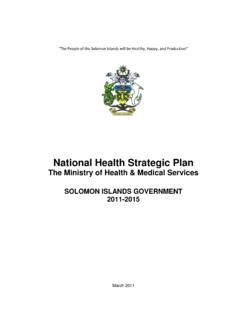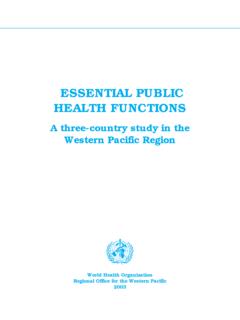Transcription of MODULE Promoting Mental Health and Wellness 6
1 MODULE . Promoting Mental Health and Wellness 6. Epidemiology of Mental Health Problems related to NCDs 3. Benefits of Promoting Mental Health 6. Factors that Contribute to Mental Health Problems 7. Promoting Mental Health Across the Lifespan 8. Strategies to Promote Mental Health in Different Settings 9. Promoting Mental Health Among Individuals with Chronic Conditions 17. Creating a Supportive Environment for Promoting Mental Health 28. MODULE Promoting Mental Health 6 and Wellness Introduction Mental Health has been defined by WHO (1999) as a state of well-being in which the individual realizes his or her own abilities, copes with the normal stresses of life, works productively and fruitfully, and makes contributions to the community.
2 Mental Health is considered the foundation for well-being and effective functioning for an individual and for a community. A community of mentally healthy individuals is therefore empowered, productive, and resilient. Promoting Mental Health covers a variety of strategies, which aims to have positive impact on Mental Health . It involves actions that create living conditions and environments to support Mental Health and allow people to adopt and maintain healthy lifestyles. This includes programs and policies that aim to foster individual and community Mental Health towards healthy living. The connection between chronic noncommunicable diseases (NCDs) and Mental Health problems has been shown to be bi-directional. Chronic NCDs can lead to certain Mental Health issues just as Mental illness can also contribute to development of chronic NCDs.
3 Objectives At the end of this MODULE , you should be able to: 1. Describe the magnitude of Mental Health problems related to NCDs 2. Explain the benefits of Promoting Mental Health 3. Discuss principles and guidelines for Promoting Mental Health across life span 4. Describe strategies to promote Mental Health among: a. School-based population b. Workplace population c. Community-based population 5. Identify key areas for promotion of Mental Health among individuals with chronic conditions 6. Create a supportive environment for Mental Health promotion 7. Advocate for a supportive environment on physical activity 2. Epidemiology of Mental Health Problems Related to NCDs Mental Health problems are increasing and dramatically adding to the global burden of disease and disability worldwide.
4 Mental disorders account for about 14% of global burden of disease: depression, alcohol/drug abuse, and psychoses (WHO, 2007). The public Health impact of Mental illness is that it can cause disability for prolonged periods. Mental illness has been found to be the third most common form of disability in the Philippines in 2000 after visual and hearing impairments, with a prevalence rate of 88 cases per 100,000. population (National Statistics Office, 2000). The region with the highest prevalence rate of Mental illness is Southern Tagalog at cases per 100,000 population, followed by NCR at per 100,000 population and Central Luzon at per 100,000 population (DOH National Objectives for Health , 2005-2010). Figure Morbidity Rate for Mental Illness by Region (2000).
5 WHO (2007) reports that about half of Mental disorders begin before the age of WHO reports that fourteen. Around 20% of the world's children and adolescents are estimated to about 50% of Mental have Mental disorders or problems, with similar types of disorders being reported disorders begin before across cultures. In the Global School Health Survey (2007), 17% of students 13- the age of fourteen. 15 years old with specific Mental Health problems described to be feeling lonely most of the time or always during the last 12 months , seriously considered attempting suicide during the past 12 months and reported having no close friends . 3. A study in the workplace showed that 32% of government employees in 20 agencies in Metro Manila reported experiencing Mental Health problems at least once in their lifetime (DOH-NEC, 2006).
6 The three most common diagnoses were specific phobias (15%), alcohol abuse (10%) and depression (6%). Figure Mental Health Concerns among Adolescents 13-15 y/o (GSHS, 2007). In a population survey (DOH, National Objectives for Health , 2005-2010), the more frequently reported symptoms of Mental Health problem were excessive sadness, confusion and forgetfulness, no control over the use of cigarettes and alcohol, and delusions. Excessive sadness, forgetfulness and confusion increase with age. Cigarette and alcohol abuse affect adults and adolescents more than they do the older persons. The prevalence of Mental illness is reportedly highest among the older age groups. Figure Most Commonly Reported Symptoms of Mental Illness (2000).
7 4. Mental disorders such as depression, alcohol, substance abuse, child/adolescent development problems are among the risk factors for some NCDs and can also contribute to unintentional and intentional injury. Comorbidity or the co-occurrence of physical and Mental conditions is common. A community survey showed that those who report significant emotional distress reported high rates of high cholesterol, high blood pressure, obesity, asthma and diabetes (NYC Department of Health and Mental Hygiene, 2003). Respondents also reported risk behaviours that potentially increase the incidence of poor Health , such as lack of exercise, binge drinking, smoking and poor nutrition. Several studies provide evidence linking Mental Health domains to physical conditions, particularly on the interactions between depression and related illnesses including anxiety, and heart disease (Kuper, Marmot & Hemingway, 2002), stroke (Carson et al.)
8 , 2002), diabetes (Anderson et al., 2001), asthma (Goldney et al., 2003) and cancer (De Boer et al., 1999). Depression occurs in 16 23% of patients with coronary artery disease and may precede myocardial infarction in 33 50% of cases. Depression and anxiety have also been found in patients following coronary artery bypass graft and in patients with congestive heart failure. Local data show that almost half (47%) of those diagnosed to have long-standing physical illness in selected tertiary hospitals in the Philippines had anxiety and depression and other psychiatric illnesses (Perlas, et al., 1996). Behaviours such as tobacco and alcohol use and other risk and protective factors such as exercise and overweight may influence onset, course and outcomes of cardiac pathology through complex causal and associative pathways.
9 Depression and anxiety may worsen prognosis for stroke. Depression and anxiety can influence the course of diabetes and are associated with poor control of blood glucose levels and a range of complications. Increased rates of depression have also been found in people with asthma. Mental disorders such as depression, alcohol and substance abuse are among the risk factors for some NCDs. Several studies provide evidence linking Mental Health conditions particularly depression to physical conditions and illnesses including anxiety, heart disease, stroke, diabetes, asthma and cancer. 5. 2. Benefits of Promoting Mental Health Given the association between Mental Health and physical conditions and the link between Mental Health problems and increased risk behaviors, Promoting healthy lifestyle is incomplete without Promoting Mental Health .
10 Three Levels of Mental Health Promoting Mental Health involves looking beyond prevention. Promotion It means looking at the relationship between Mental well-being Strengthening Individuals and physical Health ; behavioral problems; violence; child abuse; Strengthening communities domestic violence; drug and alcohol misuse; living and working Reducing structural barriers to conditions such as homelessness, poverty, and unemployment; Mental Health and risk taking behavior such as smoking and unsafe sex. It means addressing the Mental Health impact of public policies, programs and plans. Mental Health promotion emphasizes two key concepts: power and resilience. Power is defined as a person's, group's or community's sense of control over life and the ability to be resilient (Joubert & Raeburn, 1998).















